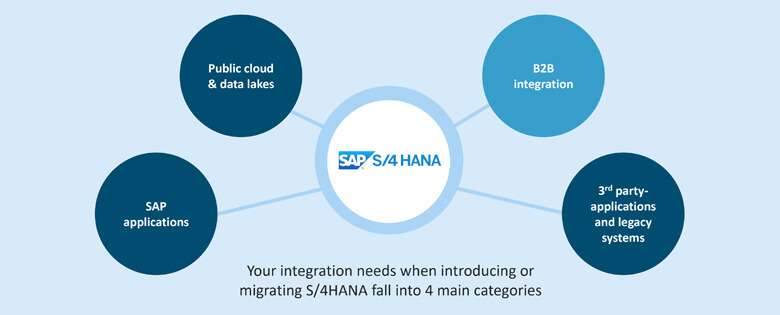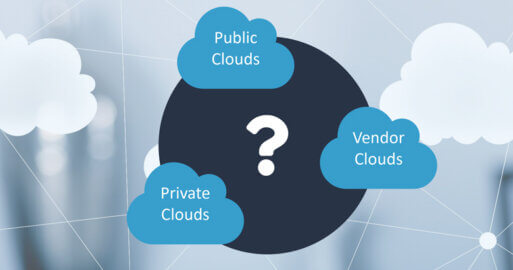6 Reasons Why SAP S/4HANA Integration for B2B is Particularly Challenging

The endpoints which need integrating when migrating to – or introducing – SAP S/4HANA vary greatly. They are determined by factors such as an organisation’s IT environment, its industry, its digitalisation approach or whether it follows a multi cloud strategy. However, the majority of S/4HANA integrations are in one of these four main categories:
- 3rd party applications and legacy systems
- B2B integration
- Public cloud and data lakes
- SAP applications
This post looks in detail at S/4HANA B2B integration.
Integrating S/4HANA in B2B scenarios

B2B is the most challenging and varied category in SAP S/4HANA integration. Here are 6 key reasons why:
- By definition, B2B integration means meddling with a company’s core processes and its supply chain.
In a number of industries, a company’s core processes depend on smooth, reliable automated connections with business partners. The same is true of certain compliance or clearing processes. The higher the number of fully-integrated partners, the more complex connections there are to manage and maintain long term. And these connections are integral to the organisation functioning. - B2B integration has the widest range of technical challenges found in S/4HANA integration.
Although there are a number of norms and standardised procedures for transporting data and for data and document structures, there is still a high rate of non-standard elements. And as new technologies are being introduced, they are not necessarily replacing the old ways. Instead, the range of technologies is growing. This can be seen in the increasing use of REST APIs and Web APIs to call up information for real time processes. Experts do not expect these to replace older methods anytime soon, rather to exist alongside them. The advantage is more options for integrating business partners. However, as there is a lack of industry standards for APIs, with individual business partners often setting their own, this is drastically expanding the range of B2B integration needs. In addition to the lack of standardization, another factor speaks against replacing existing processes: Why would a company want to introduce new technologies if they do not bring about significant improvements in terms of time, cost or quality for the company’s own specific needs? As they say, ‛if it ain’t broke, don’t fix it’. Therefore, the faithful, tried and tested ways have not yet disappeared, as can often be witnessed in B2B integration. - Maintaining connections to external business partners or authorities involves regular updates as partners make their own changes.
This applies to technical requirements such as maintaining the certificates needed for transmitting data, as well as changes and alterations to digital file structures. - Companies using SAP S/4HANA face uncertainty in choosing and getting to grips with the right interface.
As this issue is particularly critical, it is covered in its own dedicated blog post “Bye, Bye IDoc? What interface technologies will SAP S/4HANA offer, compared to SAP ECC?“. - B2B integration requires a strong understanding of a company‘s business needs and processes as well as the technology to make it all happen.
Many companies cannot reasonably expect employees to have the necessary knowledge in all three of these areas, which would be necessary to successfully map and monitor these integrations. - B2B integration involves ensuring processes still comply with specific and complex legislation.
This becomes particularly evident when government agencies are directly or indirectly involved in a process. The classic example is e-invoicing, where each country has its own stipulations and requirements. Another case is connecting to various customs authorities when using SAP Global Trade Services (GTS).
Don’t forget that most corporate IT infrastuctures have evolved over the years. Very few companies have already taken the time to modernise, streamline and standardise their IT infrastructures. To ensure a clean migration to S/4HANA, either a company will need to seriously declutter before migrating, or will need to work with an experienced integraion partner to ensure that everyone and everything is smothly and reliably networked before SAP S/4HANA goes live in your organisation.
Why not read more on SEEBURGER’s solutions for integrating with SAP S/4HANA? And find out more on all the aspects you need to consider in this monumental task in our posts on SAP S/4HANA integration. For one thing is clear; S/4HANA integration is best left to the experts.
Thank you for your message
We appreciate your interest in SEEBURGER
Get in contact with us:
Please enter details about your project in the message section so we can direct your inquiry to the right consultant.
Written by: Thomas Kamper
Thomas Kamper, SVP Strategic Product Management, is responsible for strategic product initiatives related to all SEEBURGER’s business integration technology and solutions. The focus is currently on API solutions and Big Data. In addition, he is responsible for solutions that enable organizations to master challenges of visibility and to control the proper execution of digitalized business processes. Thomas rejoined SEEBURGER December 2017. Before, he worked for many years as a hands-on interim manager and business advisor supporting C-level executives within software and cloud service providers to make their strategic product initiatives successful.





